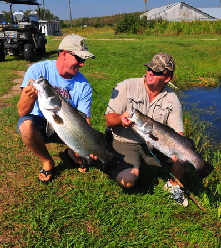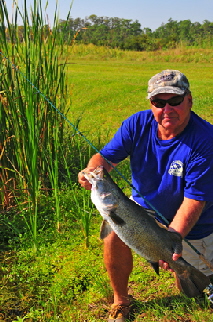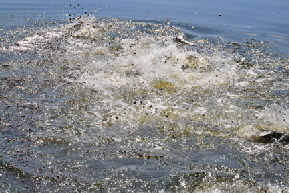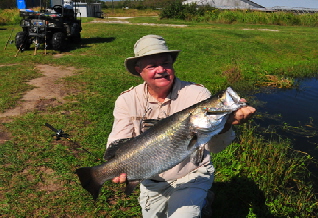|
Outback Fish in Osceola's Backyard
Check out the strong fighting barramundi imported from Australia and currently available to central Florida anglers.
By Larry Larsen
 Byron Hennecy runs Osceola Outback Adventures, a guide service that offers a unique opportunity for
Floridians. For over 3 years now, the Florida native and fire-fighter has been offering fishing for Barramundi, an Australian species that is similar to
our snook. He is the only guide in the U.S. with access to such a fishery that exists in several 4 to 6-acre private property ponds in a remote area of
Osceola County. The fish farm ponds are obviously stocked with the exotic gamefish and the permit to raise them as a food fish is the only one ever issued by the Florida Fish and Wildlife Commission. Byron Hennecy runs Osceola Outback Adventures, a guide service that offers a unique opportunity for
Floridians. For over 3 years now, the Florida native and fire-fighter has been offering fishing for Barramundi, an Australian species that is similar to
our snook. He is the only guide in the U.S. with access to such a fishery that exists in several 4 to 6-acre private property ponds in a remote area of
Osceola County. The fish farm ponds are obviously stocked with the exotic gamefish and the permit to raise them as a food fish is the only one ever issued by the Florida Fish and Wildlife Commission.
"An average group of people will usually catch around 80 fish in the four hours," says Byron. "This operation is the only place in the Northern Hemisphere where you can catch a
barramundi on hook and line."
There are reportedly over 2,000 fish in each pond, and all barramundi fishing is catch and release. For a small additional fee, clients are able to keep a few fish. The
average 3-year old fish runs about 10 pounds and they are full of power. On our trip, we caught several in the 11 and 12 pound range and my largest and last fish was close to 14 pounds.
'The largest barramundi taken from the ponds is a 16-pounder," Byron says, "and we have had well over a couple of hundred in the 14 pound range caught in 2008.
These fish make a great gamefish."
There are 9 ponds on the property and three currently have big barramundi in them. The others will be stocked with young barra in the spring, according to Byron. The
one inch long fingerlings are flown in from Australia on a Quantas jet. They are kept in concrete vats in an enclosed hatchery building on property until they have grown
to 5 or 6 inches in length and then they are transferred into the ponds.
 The barramundi and our snook (and the Nile perch) evolved from a common ancestor that existed when the continents were still
one land mass millions of years ago. The fish today are similar in appearance but the barra have a deeper body. They do not have the stripe down the side nor
is their head as large as our snook's. The barras are an estuary fish that live well in either fresh or salt water. They need to reach salt water in order to
spawn and they can reach up to 80 pounds in land-locked environments. The barramundi and our snook (and the Nile perch) evolved from a common ancestor that existed when the continents were still
one land mass millions of years ago. The fish today are similar in appearance but the barra have a deeper body. They do not have the stripe down the side nor
is their head as large as our snook's. The barras are an estuary fish that live well in either fresh or salt water. They need to reach salt water in order to
spawn and they can reach up to 80 pounds in land-locked environments.
When they arrive from Australia, they have already been converted to a fresh water environment. The primary concern about raising the hardy fish is having
some unusually cold weather. Once the water temperature gets down to about 64 degrees they start to die off, and at 60 degrees they will have big fish kills. Fishing reportedly shuts off at around 67
degrees. As a result, there is very little fishing done in January or February on the property.
Fortunately, Byron is able to pump in lots of 80-degree water from a 180-foot-deep well during potentially frigid times. That helps keep the water slightly warmer
and provides the fish with a warm water pocket of protection where they can congregate on one side of the pond.
There is no environmental danger with the fish since they can't reproduce. They are all born the same sex and need saltwater to change sex and reproduce. The ponds
on the property are also non-discharge and totally self contained. In fact, the facility is regulated by state agencies for restricted fish species and monitored closely.
 The number of visiting anglers per month varies but Byron scheduled about 20 fishing trips per month in 2007 and just under that number in 2008. Each trip
booking is set up for 4 anglers fishing 4 hours, so the overall participation in 2007 was about 800 anglers. All tackle and soft drinks are furnished. Most visitors will fish
Impoundment #5 and #6 which started out with about 15,000 fish and now have about 4,000 fish each. That is still a lot of giant fish in little ponds, but they are well
fed and utilized for the primary purpose of their being - to sell them to the seafood market. The number of visiting anglers per month varies but Byron scheduled about 20 fishing trips per month in 2007 and just under that number in 2008. Each trip
booking is set up for 4 anglers fishing 4 hours, so the overall participation in 2007 was about 800 anglers. All tackle and soft drinks are furnished. Most visitors will fish
Impoundment #5 and #6 which started out with about 15,000 fish and now have about 4,000 fish each. That is still a lot of giant fish in little ponds, but they are well
fed and utilized for the primary purpose of their being - to sell them to the seafood market.
The best time to fish late in the summer or early fall is late afternoon or evening with topwater plugs, Yozuri or MirrOLure plugs fished with very slow subtle jerks.
They will come up from beneath the bait to get it. If you jerk it too fast, they will spook. In the spring and early summer, mid-day is the best bite. The hotter the day,
the better the fishing. Cloud cover makes for a better topwater bite and even passing clouds will improve the bite noticeably.
"You can catch them just as good at night as you can in the daylight," adds the guide. "Their eyes are a florescent green when caught in the daytime but at night,
their eyes are blood red. One piece of advice I can give is to not book your trip on a full moon. You just won't catch them near as well on the day before to a day or
two after the full moon as you will on a new moon."
"The barramundi are structure oriented, just like our American snook," Bryon continues. "In the summer, the barra will strike lures around the grassy perimeter of
the ponds. If you hook a fish near one of the culverts or paddle-wheel aerators, the barra will actually run toward the obstruction and try to cut the line on it. Care must
be used when handling the fish due to their sharp gill covers. "
The top artificial bait varies. It might be topwater one day, and the next day white jigs can be very hot, according to Kissimmee angler Ken Baker, a frequent visitor to
the barramundi ponds. In fact, he has seen diving crankbaits to be hot, as well as topwater plugs and jigs. Bryon even relates that one young angler used Berkley
Gulp Nuggets to catch a bunch one afternoon. Flies also work and I even found a broken-off fly inside the mouth of one of the barra that I caught.
 Worst case, you can always put one of the commercial fish pellets (from their normal hatchery feed) on a hook and
toss it out for a strike. Byron keeps the barramundi in the ponds well fed with pellets, so the fish are certainly used to feeding on them. The manager slows the feeding when the fish become the
"perfect" size for the seafood market. He does however believe that they can get some of the fish up to about 35 pounds in their ponds. Worst case, you can always put one of the commercial fish pellets (from their normal hatchery feed) on a hook and
toss it out for a strike. Byron keeps the barramundi in the ponds well fed with pellets, so the fish are certainly used to feeding on them. The manager slows the feeding when the fish become the
"perfect" size for the seafood market. He does however believe that they can get some of the fish up to about 35 pounds in their ponds.
The guide was born and raised in the fish business; his dad has been a tropical fish farmer for 48 years. At one time they had 500 smaller tropical fish
ponds on their property south of Holopaw in the middle of nowhere. Today, Byron manages the barramundi operation for another man who has purchased some of
the property initially for a shrimp raising operation.
Byron also guides bass anglers on Lake Kissimmee, the St. Johns River and West
Lake Tohopekaliga and saltwater anglers interested in redfish, snook, trout and tarpon. For further information, contact Byron Hennecy of Osceola Outback
Adventures at 1-407-908-3216, email bkhennecy@aol.com or visit his website at www.OsceolaOutback.com.
|